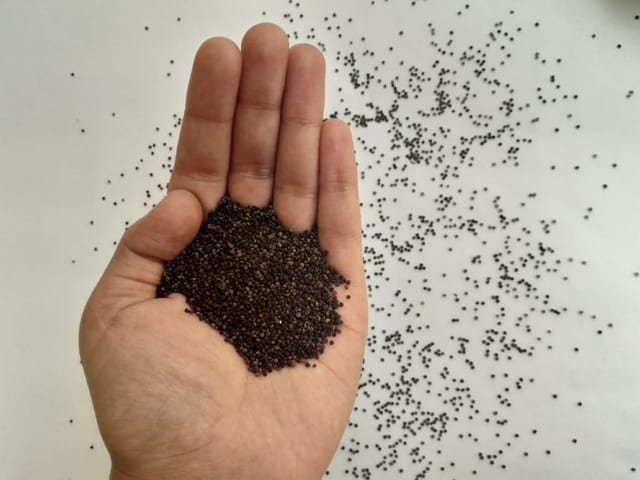Cleome viscosa (Jakhiya)- A Garhwali spice that makes every food tempting. This blog will be super-interesting as we will be taking you to hills and will give you a taste of its secret ingredient-Jakhiya. So, make sure to read it to the last.

Jakhiya is a seed of the Cleome viscosa plant and is mostly grown in the Garhwal and Kumaon region of Uttarakhand. Cleome viscosa is a common weed, which grows naturally in the abandoned crop field, or you can grow it in between your crops. The Cleome viscosa plant and its parts (leaves, seeds, and roots) are also used as a medicinal herb.
Cleome viscosa common name is wild mustard or dog mustard. These seeds are small, dark black, or brown in color. People of Uttarakhand are in love with these tiny seeds. Pahari people use it for tempering all their cuisine to make it more delicious and authentic. You can also say it is the magic ingredient of Garhwali cuisine, which gives food a heavenly taste.
Cleome viscosa (Jakhiya)- A Taste of Hills
Jakhiya is a Garhwali substitute of cumin seed (jeera) and mustard seed (sarso) in Uttarakhand. You will fall in love with its sharp aroma and its crunchy taste. It is because of its unique crunchy flavor, Pahari prefers over cumin and sarso seed.

You can use it for tempering all types of vegetables, pulses, green veggies, and curries. Adding this spice will give you an authentic taste of hills.
Here is the cooking tip for all non-garhwali people, the oil should be hot enough before adding jakhiya. Otherwise, it won’t cook properly and won’t give that crunchy taste. Add it only when the oil is smoky, and it should crackle up as soon as you add it.
You won’t get it in any grocery store or supermarket. If you have any garhwali friends, you can ask them to get it for you or, you can order it online on Amazon through the link given below:
Cleome viscosa Medicinal Uses
Cleome viscosa plants are in use for medicinal purposes since ancient times. As we have already mentioned, all parts of this plant have medicinal properties.
As per Ayurveda, this plant is a useful remedy for skin diseases, malarial fevers, blood diseases, leprosy, and uterine complaints.
The leaves of the plant get used in healing wounds and ulcers. The leaves juice is used as a medicine for pus discharge from the ear.
The seeds of the plant are anthelmintic and carminative.
Also, studies have proven that Cleome viscosa inhibits microbial growth, which establishes it as an anti-microbial agent.
Additionally, According to the Treatise on Indian Medicinal Plants, published by the Council for Scientific and Industrial Research in 1991, the Cleome viscosa plant is used for treating fever, inflammations, bronchitis, liver ailments, and diarrhea. Fresh oil extracted from crushed seeds gets used for treating infantile convulsions and mental disorders.
Jakhiya Special Recipe
Even though jakhiya gets used to temper all food cuisines in Uttarakhand, one of my favorites is jakhiya wale aloo ke gutke. You can also try it at home, using my recipe.
Aloo ke Gutke
Aloo ke gutke is a famous Garhwali and Kumaoni dish. You can try making this simple dish at your home. You surely will fall in love with the simplicity of this Pahari food.
Ingredients:
- Pahari Aloo – 4 Large
- Mustard Oil – 3 Tablespoon
- Jakhiya – 1 Tablespoon
- Garlic – 4-5 Cloves
- Dry Red Chillies – 3-4
- Salt – As per your taste.
- Turmeric Powder – 1/2 Tablespoon
- Coriander Powder – 1 Tablespoon
- Amchur Powder- 1/4 Tablespoon
Recipe:
- Heat mustard oil in a heavy bottom kadhai.
- Add jakhiya when oil gets smoking hot and let it crackle. Now reduce the flame and add garlic and dry red chillies and saute for few seconds.
- Add the sliced potatoes and all the spices except amchur powder and mix well.
- Cook on low flame for 10-15 minutes, keep tossing occasionally.
- Add amchur powder, cook for another 2-3 minutes and turn off the flame.
- Garnish with fresh coriander leaves.
Conclusion
Cleome viscosa will definitely impress you with its crunchy taste and unique flavor. It is gaining popularity with time, and now, farmers are also paying attention to the cultivation of this spice.
We hope this article was helpful for you. If you have any queries, please drop us a comment in the comment section.
Recommended Readings:

